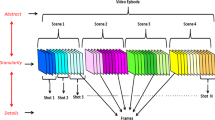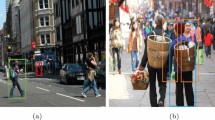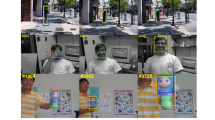Abstract
In video surveillance, person re-identification is an important task of recognizing individuals in diverse locations over different non-overlapping camera views under the condition of large illumination variations. In order to deal with these challenges, two different and efficient color-based-methods are proposed for single-shot person re-identification in this article, which uses the Gaussian mixture model to combine with color histograms (low-level feature) and the dense salient patches (mid-level feature) as the color features. Both the two proposed systems are three-stage processes. The first stage is the image enhancement by illumination normalization, and it used to deal the intensity variations. The second stage includes pedestrian segmentation and human region partition, which separates the background (BG) and foreground (FG) and locates the body segments to improve the accuracy of feature extracting and matching. The third stage is to perform feature extracting and matching. A Gaussian mixture model is used in the first system, GMMWCH, to generate the weighted color histogram as the color features, which has a low computation time and a good recognition rate. For the second system, SaliGMMWCH, the dense correspondence is used to link the color histogram weighted by the Gaussian mixture model to find salient regions. Even though that takes more time for computation, the SaliGMMWCH retains a better recognition rate than GMMWCH. In addition, the correct match can be chosen by matching the similarity scores of different feature with an appropriate weight selection. Both the proposed methods have been tested on the benchmark, VIPeR and PRID 2011, for evaluation. The experimental results demonstrate superior recognition rate and execution performance by using the proposed methods compared to other representative methods.

















Similar content being viewed by others
References
Wei, Y.-L., & Lin, C.-H. (2013). Single-shot person re-identification by Gaussian mixture model of weighted color histograms. In intelligent signal processing and communication systems (ISPACS).
Du, Y., Ai, H., Lao, S. (2012). Evaluation of color spaces for person re-identification. In International Conference on pattern recognition (ICPR), pp. 1371–1374.
Gray, D., & Tao, H. (2008). Viewpoint invariant pedestrian recognition with an ensamble of localized features. In European Conference on computer vision (ECCV), pp. 262-275.
Bak, S., Corvee, E., Bremond, F., Thonnat, M. (2010). Person re- identification using Haar-based and DCD-based signature. In Workshop on Activity Monitoring by Multi-Camera Surveillance Systems.
Prosser, B., Zheng, W.-S., Gong, S., Xiang, T. (2010) Person re-identification by support vector ranking. In British Machine Vision Conference (BMVC).
Hirzer, M., Beleznai, C., Roth, P., Bischof, H. (2011). Person re-identification by descriptive and discriminative classification. Image Analysis.
Schwartz, W., & Davis, L. (2009). Learning discriminative appearance-based models using partial least squares. In XXII Brazilian symposium on computer graphics and image processing (SIBGRAPI).
Leng, Q., Hu, R., Liang, C., & Wang, Y. (2013). Person re-identification based on contextual characteristic. Electronics Letters, 49, 1074–1076.
Tao, D., Jin, L., Wang, Y., Yuan, Y., & Li, X. (2013). Person re-identification by regularized smoothing KISS metric learning. IEEE Circuits and Systems for Video Technology, 23, 1675–1685.
Hotelling, H. (1993). Analysis of a complex of statistical variables into principal components. Journal of Education & Psychology, 24(7), 417–441.
R. Zhao, W. Ouyang, and X. Wang (2013) Person re-identification by salience matching. In International Conference on Computer Vision (ICCV).
T. Joachims, T. Finley, and C.-N. J. Yu (2009). Cutting-plane training of structural svms. Machine Learning, 77(1), 27–59.
Farenzena, M., Bazzani, L., Perina, A., Murino, V., Cristani, M. (2010). Person re-identification by symmetry-driven accumulation of local features. In computer vision and pattern recognition (CVPR), pp. 2360-2367.
Jojic, N., Perina, A., Cristani, M., Murino, V., Frey, B. (2009). Stel component analysis: Modeling spatial correlations in image class structure. In computer vision and pattern recognition (CVPR), pp. 2044-2051.
Chang, Y.-C., Chiang, C.-K., Lai, S.-H. (2012). Single-shot person re-identification based on improved random-walk pedestrian segmentation. In intelligent signal processing and communication systems (ISPACS).
Zhao, R., Ouyang, W., Wang, X. (2013) Unsupervised salience learning for person re-identification. In Computer Vision and Pattern Recognition (CVPR).
Lowe, D. G. (2004). Distinctive Image Features from Scale-Invariant Keypoints. International Journal of Computer Vision, 60, 91–110 Springer.
Ma, B., Su, Y., Jurie, F. (2012). Local descriptors encoded by fisher vectors for person re-identification. In European Conference on computer vision (ECCV).
Ma, B., Su, Y., Jurie, F. (2012). Bicov: A novel image representation for person re-identification and face verification. British Machive Vision Conference, Sep 2012, Guildford, United Kingdom, p. 11.
Wang, X., Doretto, G., Sebastian, T., Rittscher, J., Tu, P. (2007). Shape and appearance context modeling. In International Conference on computer vision (ICCV).
Gheissari, N., Sebastian, T., Hartley, R. (2006). Person re-identification using spatiotemporal appearance. In Computer Vision and Pattern Recognition (CVPR).
Bak, S., Corvee, E., Bremond, F., Thonnat, M. (2010). Person re-identification using spatial covariance regions of human body parts. In Advanced Video and Signal-Based Surveillance.
Cheng, D., Cristani, M., Stoppa, M., Bazzani, L., Murino, V. (2011). Custom pictorial structures for re-identification. In British Machine Vision Conference (BMVC).
Zheng, W-S., Gong, S., Xiang, T. (2011). Person re-identification by probabilistic relative distance comparison. In Computer Vision and Pattern Recognition (CVPR).
Gray, D., Brennan, S., Tao, H. (2007). Evaluating appearance models for recognition, reacquisition, and tracking. In 10th IEEE International workshop on performance evaluation of tracking and surveillance (PETS), 09/2007.
Ma, K., & Ben-Arie, J. (2012). Vector array based multi-view face detection with compound exemplars. In computer vision and pattern recognition (CVPR).
Liu, C., Yuen, J., Torralba, A. (2011). Sift flow: Dense correspondence across scenes and its applications. In Transactions on Pattern Analysis and Machine Intelligence (TPAMI).
Byers, S., & Raftery, A. (1998). Nearest-neighbor clutter removal for estimating features in spatial point processes. Journal of the American Statistical Association, 93(442), 577–584.
Roth, P. M., Hirzer, M., Köstinger, M., Beleznai, C., Bischof, H. (2014). Mahalanobis distance learning for person re-identification. In Person Re-Identification, Advances in Computer Vision and Pattern Recognition, pp 247–267.
Kostinger, M., Hirzer, M., Wohlhart, P., Roth, P. M., Bischof, H. (2012). Large scale metric learning from equivalence constraints. In Computer Vision and Pattern Recognition (CVPR).
Hirzer, M., Roth, P. M., Bischof, H. (2012). Person re-identification by efficient metric learning. In Advanced Video and Signal-Based Surveillance.
Weinberger, K. Q., & Saul, L. K. (2008). Fast solvers and efficient implementations for distance metric learning. In Machine Learning.
Dikmen, M., Akbas, E., Huang, T. S., Ahuja, N. (2010). Pedestrian recognition with a learned metric. In Asian Conference on computer vision (ACCV).
Davis, J. V., Kulis, B., Jain, P., Sra, S., Dhillon, I. S. (2007) Information-theoretic metric learning. In International Conference on Machine learning (ICML), pp 209-216.
R. Layne, T.M. Hospedales and S. Gong (2014). Attributes-based Re-Identification. In S. Gong, M. Cristani, S. Yan, C. C. Loy (Ed.), Book: Person Re-Identification. Chapter: 4. (pp. 93–117). Berlin, Springer.
P. M. Roth, M. Hirzer, M. Köstinger, C. Beleznai, and H. Bischof, (2014) Mahalanobis distance learning for person re-identification. In S. Gong, M. Cristani, S. Yan, C. C. Loy (Ed.), Book: Person Re-Identification. Chapter: 12. (pp. 247–267). Berlin, Springer.
Acknowledgments
This work was supported by the National Science Council (NSC), Taiwan under No. 102-2221-E-011-139-.
Author information
Authors and Affiliations
Corresponding author
Rights and permissions
About this article
Cite this article
Wei, YL., Lin, C.H. Efficient Weighted Histogram Features for Single-Shot Person Re-Identification. J Sign Process Syst 90, 477–491 (2018). https://doi.org/10.1007/s11265-017-1259-1
Received:
Revised:
Accepted:
Published:
Issue Date:
DOI: https://doi.org/10.1007/s11265-017-1259-1




